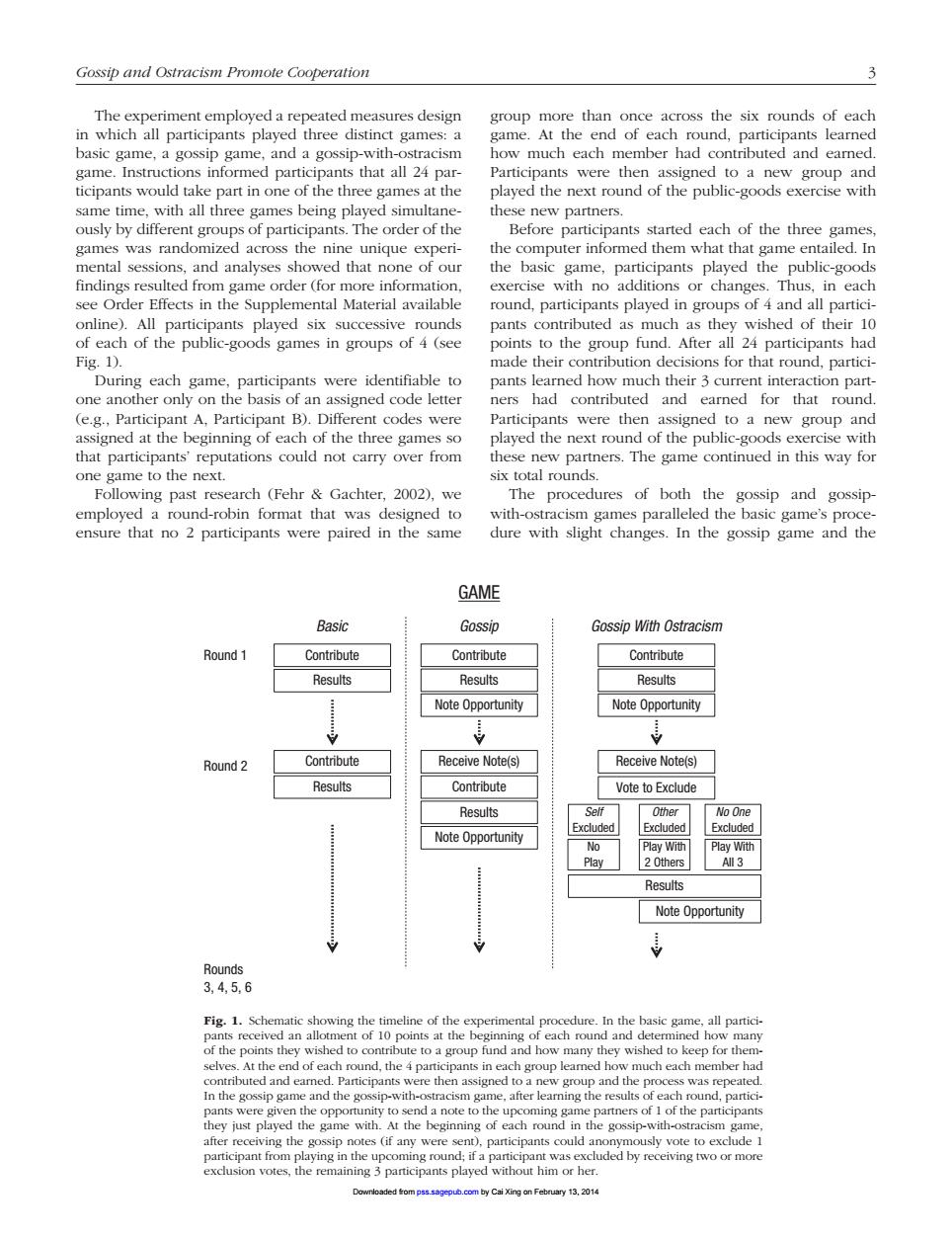正在加载图片...

Gossip and Ostracism Promote Cooperation The experiment employed a repeated measures design group more than once across the six rounds of each three distinct game game. ants that all 24 ticipants would take part in one of the three games at the played the next round of the public-goods exercise with same time,with all three games being played simultane these new partners. order of th of the three that none of ou resulted a of ou Public exercise with no additions or changes.Thus,in each see Order Effects in the Supplemental Material available round,participants played in groups of 4 and all partici pants contributed as muc s games in groups de thei During each game,participants were identifiable to pants learned how much their 3 current interaction part one another only on the basis of an assigned code letter ers had contributed and earned for that round A,Participant B).Difter ent codes were were the of the gne that the next o The to a new group an one game to the next. six total rounds Following past research (Fehr Gachter,2002),we The procedures of both the gossip and gossip GAME Basic Gossip Gossip With Ostracism Round 1 Contribute Contribute Contribute Results Results Note Opportunity Note Opportunity Round2 Contribute Receive Note(s) Receive Note(s) Results Contribute Vote to Exclude Results 20t 3 Results Ro Fig.1.Sch of the In the to a group h。 re th n the ism hey iust p tn3,201 Gossip and Ostracism Promote Cooperation 3 The experiment employed a repeated measures design in which all participants played three distinct games: a basic game, a gossip game, and a gossip-with-ostracism game. Instructions informed participants that all 24 participants would take part in one of the three games at the same time, with all three games being played simultaneously by different groups of participants. The order of the games was randomized across the nine unique experimental sessions, and analyses showed that none of our findings resulted from game order (for more information, see Order Effects in the Supplemental Material available online). All participants played six successive rounds of each of the public-goods games in groups of 4 (see Fig. 1). During each game, participants were identifiable to one another only on the basis of an assigned code letter (e.g., Participant A, Participant B). Different codes were assigned at the beginning of each of the three games so that participants’ reputations could not carry over from one game to the next. Following past research (Fehr & Gachter, 2002), we employed a round-robin format that was designed to ensure that no 2 participants were paired in the same group more than once across the six rounds of each game. At the end of each round, participants learned how much each member had contributed and earned. Participants were then assigned to a new group and played the next round of the public-goods exercise with these new partners. Before participants started each of the three games, the computer informed them what that game entailed. In the basic game, participants played the public-goods exercise with no additions or changes. Thus, in each round, participants played in groups of 4 and all participants contributed as much as they wished of their 10 points to the group fund. After all 24 participants had made their contribution decisions for that round, participants learned how much their 3 current interaction partners had contributed and earned for that round. Participants were then assigned to a new group and played the next round of the public-goods exercise with these new partners. The game continued in this way for six total rounds. The procedures of both the gossip and gossipwith-ostracism games paralleled the basic game’s procedure with slight changes. In the gossip game and the GAME Basic Gossip Gossip With Ostracism Round 1 Round 2 Contribute Results Contribute Results Note Opportunity Contribute Results Note Opportunity Contribute Results Contribute Results Note Opportunity Receive Note(s) Vote to Exclude Receive Note(s) Self Excluded Other Excluded No One Excluded Play With 2 Others No Play Play With All 3 Note Opportunity Results Rounds 3, 4, 5, 6 Fig. 1. Schematic showing the timeline of the experimental procedure. In the basic game, all participants received an allotment of 10 points at the beginning of each round and determined how many of the points they wished to contribute to a group fund and how many they wished to keep for themselves. At the end of each round, the 4 participants in each group learned how much each member had contributed and earned. Participants were then assigned to a new group and the process was repeated. In the gossip game and the gossip-with-ostracism game, after learning the results of each round, participants were given the opportunity to send a note to the upcoming game partners of 1 of the participants they just played the game with. At the beginning of each round in the gossip-with-ostracism game, after receiving the gossip notes (if any were sent), participants could anonymously vote to exclude 1 participant from playing in the upcoming round; if a participant was excluded by receiving two or more exclusion votes, the remaining 3 participants played without him or her. Downloaded from pss.sagepub.com by Cai Xing on February 13, 2014